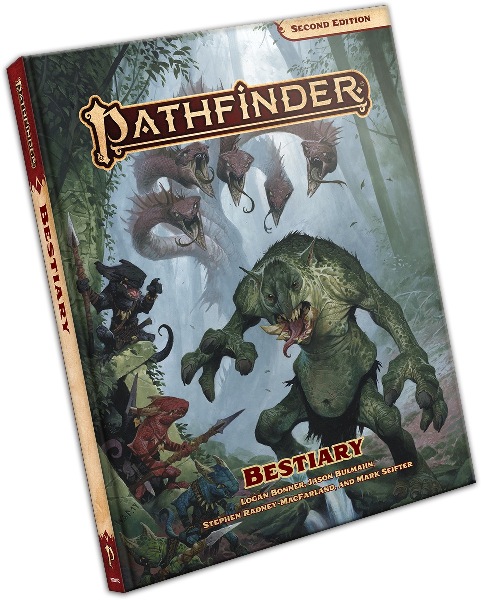
Bestiary
Bestiary is a core supplement for the epic fantasy Pathfinder, Second Edition, RPG, written by Logan Bonner, Jason Bulmahn, Stephen Radney-MacFarland, and Mark Seifter and published by Paizo.
By Aaron T. Huss

Learn more about Bestiary here
Purchase Bestiary here (paid link)
Find other Pathfinder Second Edition posts here
For starters, this is a review of Pathfinder Second Edition: Bestiary as a standalone book; it is not a review of how this book compares to its First Edition counterpart. Second, the review doesn’t contain any actual spoilers, so it’s safe for players.
Bestiary is a core supplement for Pathfinder Second Edition. Much like it’s First Edition counterpart, it is a large collection of adversaries for your players fearless heroes to face down in adventure after adventure. According to the rear cover, there are over 400 entries and I’m going to believe them as I certainly am not going to count them all. That’s just too much work. Just know that there is a chance your gaming group might not even get through every single entry in here within the context of a single campaign. Unless you slog through lots of encounters… then you might.
When I look through Pathfinder Second Edition, I see a trend that Paizo appears to have purposefully implemented throughout this new edition of Pathfinder. Like Dungeons & Dragons, Pathfinder, sits at the top of the epic fantasy pyramid filled with a plethora of fantasy RPGs beneath it. Unlike Dungeons & Dragons, Pathfinder appears to make a conscious attempt to bring tabletop RPGs into the next era of tabletop RPGs by embracing new cultural norms and identifying itself as something more than just vanilla fantasy. In the core rulebook, this was apparent with some of the nuances that go into creating a character and how characters identify themselves in game terminology. In Bestiary, Paizo looks well beyond the typical walls of vanilla fantasy and presents a list of adversaries that can be used for a multitude of fantasy game styles.
First, you have a large collection of fantasy standard creatures – dragons, kobolds, goblins, lizardfolk, animated things, giant creatures, ogres, orcs, trolls, bugbears, centaurs, golems, elementals, giants, etc. There are more than enough to go around and this encompasses your standard vanilla fantasy game enthusiasts.
Second, you have a collection of mundane creatures – boar, crocodile, lion, hyena, rat, wolf, etc. Not a lot of these, but sometimes it’s nice to break away from the fantastical elements. These are also useful for low fantasy and historical fantasy games.
Third, you have a collection of horrific creatures – demons, ghouls, dhampir, zombies, skeletons, nightmare, poltergeist, wraith, etc. Many of these are also staples in fantasy, but they are typical of darker fantasy games or those with an edge of horror in them.
Fourth, you have a collection of big creatures – dinosaurs, “great” and “greater” creatures, mammoth, etc. These are frequently found in fantasy at higher levels, but they can also be used for prehistoric fantasy settings or ones that delve into the Hollow Earth.
Fifth, you have a collection of humanoids that could someday double as PC cultures – deep gnomes, dero, drow, duergar, tiefling, gnoll, etc. These entries include multiple stat blocks for these cultures, allowing GMs to create entire armies to face.
Finally, you have a collection of cosmic beings – aeons, shoggoth, aasimar, deva, angels, etc.
Obviously this is nowhere near the full collection of adversaries, but you get the gist of it. It is a veritable collection of who’s who for a multitude of Pathfinder games, game styles, and different setting genres. It would be difficult to follow-up with the next Bestiary 2, but we’ll see what the Paizo team comes up with!

